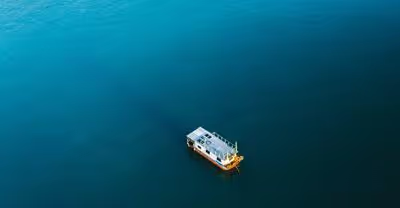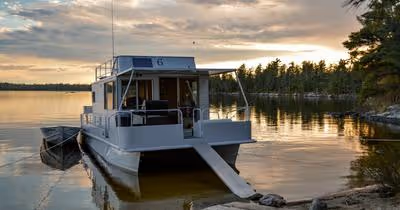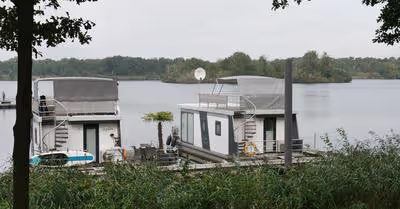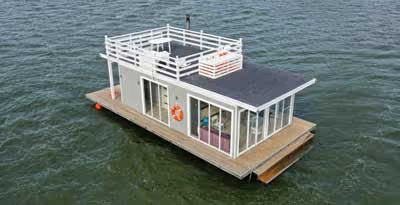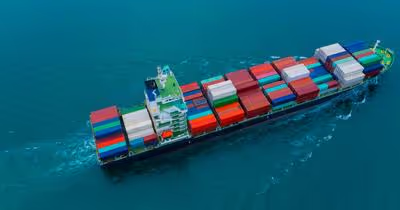
Key Takeaways
- Shipping boat speeds vary widely, with typical ranges between 17 to 24 knots.
- Vessel type, size, and cargo load significantly influence a boat's maximum speed.
- Environmental factors like weather and sea conditions impact a boat's speed.
- Speed plays a critical role in global trade, affecting delivery times and costs.
- Modern shipping boats incorporate advanced propulsion technologies for efficiency.
Ever marveled at the incredible speed of shipping boats? Let's dive into the speeds of these maritime giants and discover how fast they can go.
On average, shipping boats operate at service speeds that fall within the range of 17 to 24 knots, which is approximately 19.6 to 27 miles per hour (mph). However, the specific speed varies based on the type and purpose of the vessel.
Over the years, I’ve gained a comprehensive understanding of the factors that influence a shipping boat's speed. My expertise allows me to provide accurate and insightful information on this topic, offering valuable insights into the world of shipping and maritime logistics. You can rely on my well-informed perspective to provide a clear and comprehensive answer on how fast shipping boats go.
How Fast Does A Shipping Boat Go?
When I think about shipping boats, one of the first things that comes to mind is their size and the mammoth task they perform in moving goods across the world's oceans.
You've likely spotted these colossal vessels on the horizon near ports and pondered the speed at which these sea giants undertake their cargo ship travel or journey.
A cargo ship's speed is measured in knots (nautical miles per hour). Most cargo ships have service speeds generally ranging between 17 to 24 knots, which is approximately 19.6 to 27 miles per hour (mph), depending on ship types, functions, and other factors.
These speeds are crucial for ensuring timely deliveries and maintaining the efficiency of global trade networks.
Here's a comparative table of average speeds for various cargo boats:
As we look into the intricacies of shipping boats and their speed, it’s essential to understand the numerous factors affecting the speed. These factors intertwine to influence how swift or sluggish a boat might traverse the open seas.
We’ll explore the core elements such as engine power and propulsion, weight and displacement, the role of hull shape and design, and the impact of external environmental factors—each playing a pivotal role in defining a shipping boat’s velocity.
Hull Design and Hydrodynamic Efficiency
The design of a ship's hull is paramount in determining its hydrodynamic efficiency. The hull's contours and shape dictate how well it can navigate through water, impacting speed, stability, and fuel consumption.
An efficiently designed hull minimizes hydrodynamic drag as the ship moves through the water, reducing the resistance it encounters. This results in smoother travel and enables the vessel to attain higher speeds while using the same amount of power.
Ships with sleek, elongated hulls tend to exhibit superior hydrodynamic properties, making them more efficient and capable of achieving higher speeds compared to vessels with bulkier or less streamlined hull designs.
Engineers and naval architects employ advanced modeling and simulations to optimize hull shapes, ensuring that they strike a balance between speed, stability, and other performance criteria.
The Engine and Propulsion System
The main engine and propulsion system are the driving force behind a ship's movement. High-powered engines, when combined with advanced propulsion systems, are essential for propelling the boat forward efficiently.
However, the relationship between engine capacity and speed of a cargo ship is not linear. Increasing engine power often results in disproportionately higher fuel consumption, leading many ship operators to adopt strategies like "slow steaming."
Slow steaming involves operating engines at less than their maximum carrying capacity to reduce emissions and fuel consumption, albeit at the cost of longer transit times.
Achieving the right balance between engine power and fuel efficiency is crucial for optimizing a ship's speed while maintaining economic viability and environmental responsibility.
Cargo Load and Weight Distribution
A cargo ship's load is a primary source of revenue, but it also significantly influences its speed. Ensuring proper weight distribution within the ship is critical to seamlessly transport tens of thousands of goods.
Overloading or uneven distribution of cargo can lead to reduced speeds, increased fuel consumption, and even safety concerns.
Ship operators must carefully calculate and manage the distribution of cargo to ensure that the ship maintains its optimal performance characteristics while safely transporting goods.
Weather and Ocean Conditions
Weather conditions, including wind, waves, and tidal currents, as well as sea conditions, have a substantial impact on a ship's journey. Favorable conditions, such as tailwinds and calm seas, can aid a ship's progress, allowing it to maintain or even exceed its intended speed.
Conversely, headwinds, rough waves, and adverse ocean currents can significantly slow down a vessel. To optimize speed and safety, ship crews often adjust their routes to take advantage of favorable conditions and avoid adverse weather patterns.
Skillful navigation and weather monitoring are critical for ensuring efficient and timely voyages.
Navigation and Routing
When crossing from the Atlantic Ocean to the Pacific Ocean via the Panama Canal, shipping boats often encounter speed limitations due to the canal's narrow locks. However, once they reach the vast expanse of the Pacific Ocean, boats can typically achieve higher speeds.
On the West Coast, where major ports like Los Angeles and San Francisco are located, shipping vessels must navigate efficiently to ensure timely arrivals.
As such, selecting the right navigation and routing options is crucial for timely arrivals and fuel efficiency.
Experienced navigators take into account several factors, such as ocean currents, eddies, and seasonal variations in sea conditions. They also consider the Earth's rotational effects to determine the quickest and most fuel-efficient paths.
By carefully planning routes, ships can reduce travel times and minimize fuel consumption, contributing to cost savings and environmental sustainability.
Ship Maintenance and Condition
Regular maintenance is essential to ensure that a ship operates at its highest potential speed. Fouling on the hull, problems with the main engine, or damage to the propeller can all hinder a ship's speed and efficiency.
Routine inspections, cleaning, and repairs are vital to keep a vessel in top condition and capable of cutting through the waves effectively. Maintaining the ship's propulsion system, including engines and propellers, is equally crucial to achieving and sustaining desired speeds.
Maritime Regulations and Speed Limits
Maritime regulations and speed limits are vital tools for safeguarding both the marine environment and the safety of vessels and their crews.
They are often established in ecologically sensitive areas to protect marine ecosystems, reduce the risk of collisions in congested waterways, and mitigate the potential for ship-generated disturbances.
These regulations aim to strike a balance between the efficient movement of goods and the preservation of marine habitats, ensuring that maritime activities occur responsibly and sustainably.
Compliance with these regulations minimizes the ecological footprint of shipping and contributes to safer and more organized maritime operations. Although it may necessitate adjustments in transit times and speed, it ultimately benefits the long-term health of our oceans.
Fuel Quality and Energy Efficiency
The quality of the fuel used and a ship's overall energy efficiency are directly related to its speed and operational costs. Higher-quality fuels can lead to better engine performance, reduced emissions, and less energy loss.
As the shipping industry emphasizes more on sustainability, energy-efficient practices such as slow steaming have become more common. As mentioned, slow steaming involves operating ships at reduced speeds to minimize fuel consumption while still maintaining an economically viable speed for transportation.
Adopting energy-efficient technologies and practices is essential for enhancing a ship's overall performance and reducing its environmental footprint.
Why Are Shipping Boats So Slow?
When sailing across the vast blue stretches of our planet's oceans, there's a noticeable pace that cargo ships adhere to—a seemingly slow and deliberate stride through the waves.
Let's delve into the reasoning behind these lower speeds and why they're beneficial to the stakeholders involved.
- Slow Steaming: This practice involves operating maritime vessels at significantly reduced speeds. It's about hitting an optimum cruising speed that balances fuel economy with timely delivery. Since fuel costs are by far one of the largest expenses for shipping companies, reducing speeds can lead to substantial cost savings.
- Lower Fuel Consumption: The resistance a ship meets increases exponentially with speed. This means even a small speed reduction can lead to a large decrease in fuel consumption, making slow steaming a smart economic choice.
- Fuel Economy and Emissions: By adopting slower speeds, ships reduce fuel costs and minimize their environmental impact. Lower speeds result in lower emissions, aligning with global efforts to combat climate change.
- Optimum Speed: Identifying the optimum speed for every voyage requires careful calculation. It's not just about minimizing expenses; it's also about ensuring the on-time arrival of goods, maintaining mechanical longevity, and adhering to environmental regulations.
Importance of Speed in Shipping Boats
While slow steaming has clear advantages, it's a balance between cost savings and the demands of the global supply chain, where time is often a critical factor. This balancing act defines the pace of these massive vessels and their journeys across the seas.
Now, let’s discuss why being swift and steady across the seas is more than a need—it's a strategic force in the shipping industry.
Efficiency and Time Management
Efficiency in shipping is paramount. A swift voyage from port to port ensures timely delivery and turnover, which in turn impacts the overall supply chain. It's a balancing act between reaching the top speed of a vessel and managing fuel consumption over long distances.
Advanced tools like the correlation velocity log, which measures ship speed relative to the sea floor, facilitate precise navigation, helping to optimize travel time without compromising safety.
Competitive Advantage
In a market where time is equated with money, shipping companies that offer the fastest cargo ships can leverage that ability as a competitive advantage.
It’s not just about the pure horsepower propelling these ships forward. It’s the smart integration of economic decisions regarding routes, speed adjustments, and maximizing fuel efficiency.
Companies that skillfully manage these factors are often a step ahead of their competition.
Elevating Speed: Recent Innovations in Ship Propulsion Technology
In this fast-paced world, the maritime industry isn't just floating by; it’s steering towards significant developments in propulsion technology. I’ve observed a wave of innovations typically designed to push the boundaries of how fast a cargo boat or a container ship can go.
I’ll share insights into these exciting advancements, shedding light on the tech that's propelling ships at a higher speed than ever before.
The quest for high speed and efficiency has brought forth several cutting-edge innovations. For example, the adoption of LNG-powered engines promises to cut down on emissions and enhance the ship's horsepower.
When elevating a vessel's hydrodynamic limits, hydrofoils have been a game-changer by lifting the ship and reducing drag.
Another innovative approach is the integration of air lubrication systems, which introduce a layer of air bubbles under the hull to significantly reduce resistance in the water.
These advancements aren't just pushing ships to move faster. They are also steering the industry towards a more efficient and environmentally friendly horizon.
Also, navigational technologies such as GPS have revolutionized how general cargo ships maneuver and maintain their course at sea. The accuracy of these systems, coupled with the understanding of Doppler shift, allows for precision in velocity measurement.
This ensures that ships can traverse the oceans safely at an economical speed, which further underscores the importance of speed in shipping boats and cruise ships.




